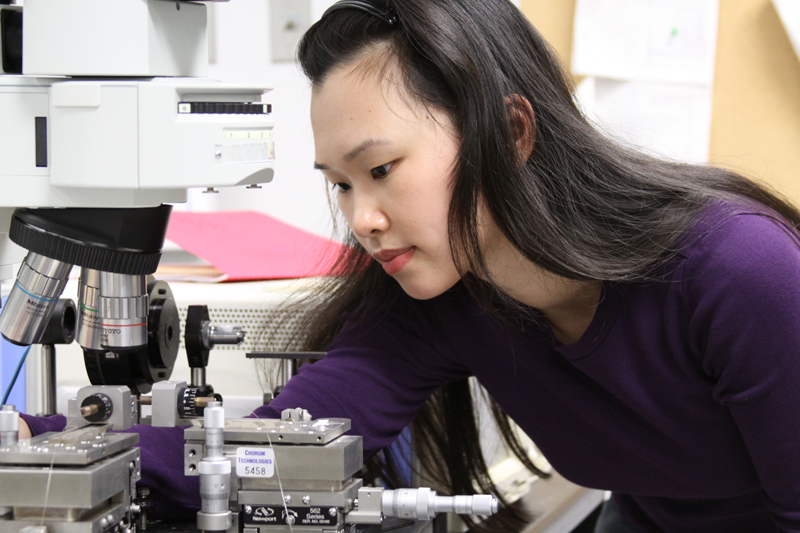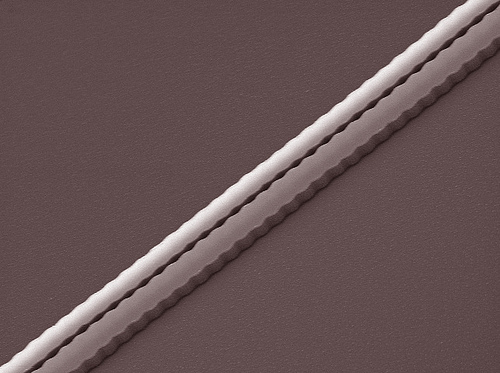Short, On-Chip Light Pulses Will Enable Ultrafast Data Transfer within Computers
San Diego, Nov. 24, 2010 -- Electrical engineers generated short, powerful light pulses on a chip – an important step toward the optical interconnects that will likely replace the copper wires that carry information between chips within today’s computers. University of California, San Diego electrical engineers recently developed the first ultra compact, low power pulse compressor on a silicon chip to be described in the scientific literature. Details appeared online in the journal Nature Communications on November 16.
|
“Our pulse compressor is implemented on a chip, so we can easily integrate it with computer processors,” said Dawn Tan, the Ph.D. candidate in the Department of Electrical and Computer Engineering at UC San Diego Jacobs School of Engineering who led development of the pulse compressor.
“Next generation computer networks and computer architectures will likely replace copper interconnects with their optical counterparts, and these have to be complementary metal oxide semiconductor (CMOS) compatible. This is why we created our pulse compressor on silicon,” said Tan, an electrical engineering graduate student researcher at UC San Diego, and part of the National Science Foundation-funded Center for Integrated Access Networks (CIAN), whose UCSD team is based in the California Institute for Telecommunications and Information Technology (Calit2).
The pulse compressor will also provide a cost effective method to derive short pulses for a variety of imaging technologies such as time resolved spectroscopy – which can be used to study lasers and electron behavior, and optical coherence tomography – which can capture biological tissues in three dimensions.
In addition to increasing data transfer rates, switching from copper wires to optical interconnects will reduce power consumption caused by heat dissipation, switching and transmission of electrical signals.
|
Pulse Compression for On-Chip Optical Interconnects
The compressed pulses are seven times shorter than the original -- the largest compression demonstrated to date on a chip.
Until now, pulse compression featuring such high compression factors was only possible using bulk optics or fiber-based systems, both of which are bulky and not practical for optical interconnects for computers and other electronics.
The combination of high compression and miniaturization are possible due to a nanoscale, light-guiding tool called an “integrated dispersive element” developed and designed primarily by electrical engineering Ph.D. candidate Dawn Tan.
The new dispersive element offers a much needed component to the on-chip nanophotonics tool kit.
The pulse compressor works in two steps. In step one, the spectrum of incoming laser light is broadened. For example, if green laser light were the input, the output would be red, green and blue laser light. In step two, the new integrated dispersive element developed by the electrical engineers manipulates the light so each spectrum in the pulse is travelling at the same speed. This speed synchronization is where pulse compression occurs.
Imagine the laser light as a series of cars. Looking down from above, the cars are initially in a long caravan. This is analogous to a long pulse of laser light. After stage one of pulse compression, the cars are no longer in a single line and they are moving at different speeds. Next, the cars move through the new dispersive grating where some cars are sped up and others are slowed down until each car is moving at the same speed. Viewed from above, the cars are all lined up and pass the finish line at the same moment.
This example illustrates how the on-chip pulse compressor transforms a long pulse of light into a spectrally broader and temporally shorter pulse of light. This temporally compressed pulse will enable multiplexing of data to achieve much higher data speeds.
“In communications, there is this technique called optical time division multiplexing or OTDM, where different signals are interleaved in time to produce a single data stream with higher data rates, on the order of terabytes per second. We’ve created a compression component that is essential for OTDM,” said Tan.
The UC San Diego electrical engineers say they are the first to report a pulse compressor on a CMOS-compatible integrated platform that is strong enough for OTDM.
“In the future, this work will enable integrating multiple ‘slow’ bandwidth channels with pulse compression into a single ultra-high-bandwidth OTDM channel on a chip. Such aggregation devices will be critical for future inter- and intra-high speed digital electronic processors interconnections for numerous applications such as data centers, field-programmable gate arrays, high performance computing and more,” said Fainman, holder of the Cymer Inc. Endowed Chair in Advanced Optical Technologies at the UC San Diego Jacobs School of Engineering and Deputy Director of the NSF-funded Center for Integrated Access Networks.
###
“Monolithic nonlinear pulse compressor on a silicon chip,” by Dawn T.H. Tan, Pang C. Sun and Yeshaiahu Fainman from the Department of Electrical and Computer Engineering at the UC San Diego Jacobs School of Engineering. Published online by the journal Nature Communications on November 16, 2010.
This work was supported by the Defense Advanced Research Projects Agency, the National Science Foundation (NSF) through Electrical, Communications and Cyber Systems (ECCS) grants, the NSF Center for Integrated Access Networks ERC, the Cymer Corporation and the U.S. Army Research Office.
Media Contacts
Daniel Kane, Jacobs School of Engineering, 858-534-3262, dbkane@ucsd.edu
Related Links
Ultrafast and Nanoscale Optics Group
Center for Integrated Access Networks



